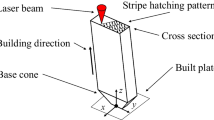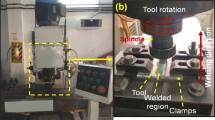Abstract
An aluminium foam sandwich (AFS) material was formed by V-die bending and roll forming. The V-bent sections showed material failure by shear fracture of the aluminium foam core and by delamination at the core-cover sheet interface. This led to a high-gull wing defect and a limited section depth that could be formed. In contrast, the roll forming process allowed the manufacture of long sections with acceptable profile depth. Only minor gull wing was observed, and this was related to a low-shear deformation of the aluminium foam core and an intact adhesion at the core-cover sheet interface. The higher material formability observed in roll forming compared to that in V-die bending was attributed to a more evenly distributed contact pressure and more homogeneous forming, due to the incremental nature of the process, combined with a continuous contact of the metal sheet with the top and bottom rolls. Some forming problems were also observed in the roll-formed AFS components, but overall, the results of this study suggest that roll forming represents a good alternative to bending or stamping for the forming of longitudinal components of simple cross section shape that are of interest to the transport, solar or housing industries.
Similar content being viewed by others
References
Banhart J, Seeliger HW (2008) Aluminium foam sandwich panels: manufacture, metallurgy and applications. Adv Eng Mater 10(9):793–802
Banhart J, Seeliger H-W (2012) Recent trends in aluminum foam sandwich technology. Adv Eng Mater 14(12):1082–1087
Schwingel D, Seeliger H-W, Vecchionacci C, Alwes D, Dittrich J (2007) Aluminium foam sandwich structures for space applications. Acta Astronaut 61(1–6):326–330
Nassar H, Albakri M, Pan H, Khraisheh M (2012) On the gas pressure forming of aluminium foam sandwich panels: experiments and numerical simulations. CIRP Ann Manuf Technol 61(1):243–246
Contorno D, Filice L, Fratini L, Micari F (2006) Forming of aluminum foam sandwich panels: numerical simulations and experimental tests. J Mater Process Technol 177(1–3):364–367
Jackson KP, Allwood JM, Landert M (2008) Incremental forming of sandwich panels. J Mater Process Technol 204(1–3):290–303
Wang J, Yang C-K (2013) Failure analysis of hydroforming of sandwich panels. J Manuf Process 15(2):256–262
Weiss M, Rolfe BF, Dingle M, Duncan JL (2005) Elastic bending of steel-polymer-steel (SPS) laminates to a constant curvature. J Appl Mech 73(4):574–579
Zu G, Song B, Zhong Z, Li X, Mu Y, Yao G (2012) Static three-point bending behavior of aluminum foam sandwich. J Alloys Compd 540:275–278
Mohr D (2005) On the role of shear strength in sandwich sheet forming. Int J Solids Struct 42(5–6):1491–1512
Zu G-y, Lu R-h, Li X-b, Zhong Z-y, Ma X-j, Han M-b, Yao G-c (2013) Three-point bending behavior of aluminum foam sandwich with steel panel. Trans Nonferrous Metals Soc China 23(9):2491–2495
Crupi V, Montanini R (2007) Aluminium foam sandwiches collapse modes under static and dynamic three-point bending. Int J Impact Eng 34(3):509–521
Halmos GT (2005) Roll forming handbook, CRC Press, Taylor & Francis Group, ISBN: 0824795636
Badr OM, Rolfe B, Hodgson P, Weiss M (2015) Forming of high strength titanium sheet at room temperature. Mater Des , Part B 66:618–626
Abeyrathna B, Rolfe B, Weiss M (2017) The effect of process and geometric parameters on longitudinal edge strain and product defects in cold roll forming. Int J Adv Manuf Technol:1–12
Marnette J, Weiss M, Hodgson PD (2014) Roll-formability of cryo-rolled ultrafine aluminium sheet. Mater Des 63:471–478
AS1391—1991 (1991) "Methods for tensile testing of metals"
ASTM-D3528 "Standard Test Method for Strength Properties of Double Lap Shear Adhesive Joints by Tension Loading", 2008
ASTM-C273 "Standard Test Method for Shear Properties of Sandwich Core Materials", (2011) 7
ASTM-C297 "Standard Test Method for Flatwise Tensile Strength of Sandwich Constructions", (2010)
ASTM-C365 "Standard Test Method for Flatwise Compressive Properties of Sandwich Cores", (2011)
Weiss M, Dingle ME, Rolfe BF, Hodgson PD (2007) The influence of temperature on the forming behavior of metal/polymer laminates in sheet metal forming. J Eng Mater Technol Trans ASME 129(4):530–537
Geomagic Qualify (2014) Available: http://www.geomagic.com/en/
Takiguchi M, Yoshida F (2003) Analysis of plastic bending of adhesive-bonded sheet metals taking account of viscoplasticity of adhesive. J Mater Process Technol 140(1–3):441–446
Andrews E, Sanders W, Gibson LJ (1999) Compressive and tensile behaviour of aluminum foams. Mater Sci Eng A 270(2):113–124
Casavola C, Dell’Orco V, Giannoccaro R, Pappalettere C (2009) Structural response of Aluminium foam sandwich under compressive loading. SEM Annual Conference, Albuquerque New Mexico USA
Zhenzhong S, Weifeng H, Haibin C, Shenggui C, Rongyong L (2011) Study on V-bending of Aluminium foam sandwich panels, Adv Mater Res Vols 181-182:281–286
Badr OM, Rolfe B, Hodgson P, Weiss M (2013) Experimental study into the correlation between the incremental forming and the nature of springback in automotive steels. Int J Mater Prod Technol 47(1–4):150–161
Abeyrathna B, Rolfe B, Hodgson P, Weiss M (2017) Local deformation in roll forming. Int J Adv Manuf Tech 88(9–12):2405–2415
Kim JK, Thomson PF (1990) Separation behaviour of sheet steel laminate during forming. J Mater Process Technol 22(2):147–161
Acknowledgements
The authors would like to acknowledge the assistance of Emeritus Professor J.L. Duncan in writing this paper. The authors further would like to thank Josu Azkune, John Hore and Marius Kaiser for their assistance in the experimental work of this paper.
Funding
The authors further appreciate the financial support of the Australian Research Council (ARC Linkage grant—LP120100111), the Wuhan Iron and Steel (Group) Corp (WISCO), DataM Sheet Metal Solutions and Australian Rollforming Manufacturers and the Global Training 2012 Program of the Basque Government.
Author information
Authors and Affiliations
Corresponding author
Rights and permissions
About this article
Cite this article
Weiss, M., Abeyrathna, B. & Pereira, M. Roll formability of aluminium foam sandwich panels. Int J Adv Manuf Technol 97, 953–965 (2018). https://doi.org/10.1007/s00170-018-1945-6
Received:
Accepted:
Published:
Issue Date:
DOI: https://doi.org/10.1007/s00170-018-1945-6




